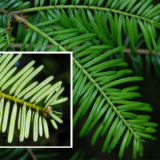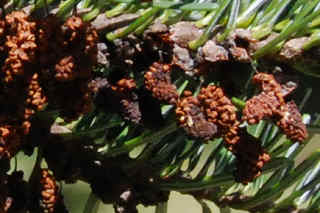Conifers have a long history, dating back nearly 300 million years at the end of the Carboniferous Age. But just when life appeared to be going great for conifers, disaster struck in the mother of all extinctions 250 million years ago. Few conifers survived. In fact, none of the conifer families from that time survive to this day. But the conifers that did survive adapted and soon flourished. Conifers ruled the earth for millions of years before the arrival of flowering plants. During the heyday of the conifers, 20,000 species covered the earth, compared to the mere 600 living today. Some of the conifer families of our time have very ancient origins.
Podocarp Family (Scientific name: Podocarpaceae.)
 |
| Tasmanian Podocarp |
This is an ancient conifer family. The first Podocarps arose 240 million years ago and include 173 living species. The Tasmanian podocarp (Podocarpus alpinus) is native to Australia. Podocarpus, comes from the Greek podos (foot) and karpos (fruit). The cone has a fleshy, berry-like scale with a single seed, similar to those on yew trees.
 |
| Monkey Puzzle Tree |
The Araucaria family (Araucariaceae)
The Araucaria family dates to 220 million years ago. Now about 40 species, it is found in the southern hemisphere, mostly in tropical rain forests. The monkey puzzle tree (Araucaria araucana) grows in the southern Andes. The unique, pointed leaves are quite prickly. The monkey puzzle tree is fire resistant and has edible nuts. It grows to 130 feet. Some trees are 2000 years old. You can find many large monkey puzzle trees growing around Portland. They originated from seedlings that were available at the World's Fair in Portland in 1905.
Ancient Natives
Although Oregon is young geologically, the ancestors of our native conifers are quite ancient. Conifer families native to Oregon include the Pine, Cypress, and Yew families.
Pine Family (Pinaceae)
The pine family includes these native genera: pine, Douglas fir*, fir, hemlock, spruce, and larch. The first pine family trees date to 150 million years ago and now total 232 species. Our most abundant native conifer, the first Douglas fir, appeared 50 million years ago.
Cypress Family (Cupressaceae)
The cypress family dates to 160 million years ago. It totals 142 species and includes cypress, new world cedars**, junipers, and the sequoia sub-family. The cypress family is the most widely distributed family, found on all continents except Antarctica. The first of the Sequoia sub-family, which includes the giant sequoia, redwood, and dawn redwood, appeared 150 million years ago in China. They first appeared in North America 90 million years ago.
 |
| Dawn Redwood |
The Dawn Redwood (Metasequoia gliptostroboides): Sequoia-like fossils have been found all over North America and Europe. The fossils were classified as Metasequoia in 1941. Metasequoia was widely described as a "living fossil" after living specimens were discovered and collected in China in 1943. Hoyt Arboretum received seeds in 1948. One of the trees grown from these seeds was the first dawn redwood to produce cones outside of China in over 6 million years. Metasequoia fossils are abundant at the John Day Fossil Beds, where they commonly grew 30 million years ago. The Oregon legislature designated Metasequoia as the Oregon State Fossil in 2005.
 |
| Pacific Yew |
Yew Family (Taxaceae)
Yews date to 175 million years ago, the most ancient of our native trees. The family now includes 28 species, mostly in the northern hemisphere. Oregon’s native yew is the Pacific yew (Taxus brevifolia). Taxol derived from the bark of this tree was used to treat cancer in the 1990’s. This rare tree would be endangered today, but researchers found a way to synthesize taxol from more common yews.
Maidenhair Tree (Scientific name: Ginkgo biloba)
The maidenhair tree is an unusual tree that is even more ancient than any of the living conifer families. Ginkgo-like fossils date to 270 million years ago. Modern Ginkgos are native to China, but have been widely planted wherever the climate is temperate or tropical.
 |
| Maidenhair Tree |
 |
| Maidenhair Fern |
If you compare the unique leaves to the leaves of the maidenhair fern, you can see why it’s called the maidenhair tree. Pollen and seeds are produced on separate trees. Since the female trees produce seeds with a soft, foul-smelling outer layer, most planted ginkgos are male. Since Ginkgos are deciduous with broad, flat leaves, you might expect that they are related to other broad-leaf trees, but this is not the case. Ginkgos are more closely related to the conifers.
____________
Notes
* Douglas fir is not a true fir. That is, it is not a member of the Abies genus. It is classified in another genus: Pseudotsuga.
**The cedars of North America are not true cedars. That is, they are not members of the Cedrus genus. The true cedars are native to the Mediterranean area and the Himalayas.
More Info
A Natural History of Conifers by Aljos Farjon. Dates from p. 67.
conifers.org






























